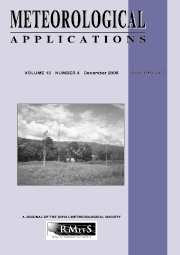Crossref Citations
This article has been cited by the following publications. This list is generated based on data provided by
Crossref.
Kallos, George
and
Pytharoulis, Ioannis
2005.
Encyclopedia of Hydrological Sciences.
Efimov, V. V.
Shokurov, M. V.
and
Yarovaya, D. A.
2007.
Numerical simulation of a quasi-tropical cyclone over the Black Sea.
Izvestiya, Atmospheric and Oceanic Physics,
Vol. 43,
Issue. 6,
p.
667.
Moscatello, Agata
Miglietta, Mario Marcello
and
Rotunno, Richard
2008.
Numerical Analysis of a Mediterranean “Hurricane” over Southeastern Italy.
Monthly Weather Review,
Vol. 136,
Issue. 11,
p.
4373.
Efimov, V. V.
Stanichnyi, S. V.
Shokurov, M. V.
and
Yarovaya, D. A.
2008.
Observations of a quasi-tropical cyclone over the Black Sea.
Russian Meteorology and Hydrology,
Vol. 33,
Issue. 4,
p.
233.
Miglietta, M. M.
Davolio, S.
Moscatello, A.
Pacifico, F.
and
Rotunno, R.
2008.
The role of surface fluxes in the development of a tropical-like cyclone in southern Italy.
Advances in Science and Research,
Vol. 2,
Issue. 1,
p.
35.
Yarovaya, D. A.
Efimov, V. V.
Shokurov, M. V.
Stanichnyi, S. V.
and
Barabanov, V. S.
2008.
A quasitropical cyclone over the Black Sea: Observations and numerical simulation.
Physical Oceanography,
Vol. 18,
Issue. 3,
p.
154.
Efimov, V. V.
Shokurov, M. V.
Yarovaya, D. A.
and
Hein, D.
2009.
Statistics of mesoscale cyclonic Eddies over the Black Sea.
Physical Oceanography,
Vol. 19,
Issue. 4,
p.
211.
Barbano, M.S.
Pirrotta, C.
and
Gerardi, F.
2010.
Large boulders along the south-eastern Ionian coast of Sicily: Storm or tsunami deposits?.
Marine Geology,
Vol. 275,
Issue. 1-4,
p.
140.
Vött, A.
Lang, F.
Brückner, H.
Gaki-Papanastassiou, K.
Maroukian, H.
Papanastassiou, D.
Giannikos, A.
Hadler, H.
Handl, M.
Ntageretzis, K.
Willershäuser, T.
and
Zander, A.
2010.
Sedimentological and geoarchaeological evidence of multiple tsunamigenic imprint on the Bay of Palairos-Pogonia (Akarnania, NW Greece).
Quaternary International,
McTaggart-Cowan, Ron
Galarneau, Thomas J.
Bosart, Lance F.
and
Milbrandt, Jason A.
2010.
Development and Tropical Transition of an Alpine Lee Cyclone. Part I: Case Analysis and Evaluation of Numerical Guidance.
Monthly Weather Review,
Vol. 138,
Issue. 6,
p.
2281.
Miglietta, Mario Marcello
Moscatello, Agata
Conte, Dario
Mannarini, Gianandrea
Lacorata, Guglielmo
and
Rotunno, Richard
2011.
Numerical analysis of a Mediterranean ‘hurricane’ over south-eastern Italy: Sensitivity experiments to sea surface temperature.
Atmospheric Research,
Vol. 101,
Issue. 1-2,
p.
412.
Conte, Dario
Miglietta, Mario Marcello
and
Levizzani, Vincenzo
2011.
Analysis of instability indices during the development of a Mediterranean tropical-like cyclone using MSG-SEVIRI products and the LAPS model.
Atmospheric Research,
Vol. 101,
Issue. 1-2,
p.
264.
Laviola, Sante
Moscatello, Agata
Miglietta, Mario Marcello
Cattani, Elsa
and
Levizzani, Vincenzo
2011.
Satellite and Numerical Model Investigation of Two Heavy Rain Events over the Central Mediterranean.
Journal of Hydrometeorology,
Vol. 12,
Issue. 4,
p.
634.
Kouroutzoglou, J.
Flocas, H. A.
Keay, K.
Simmonds, I.
and
Hatzaki, M.
2011.
Climatological aspects of explosive cyclones in the Mediterranean.
International Journal of Climatology,
Vol. 31,
Issue. 12,
p.
1785.
Chaboureau, Jean‐Pierre
Pantillon, Florian
Lambert, Dominique
Richard, Evelyne
and
Claud, Chantal
2012.
Tropical transition of a Mediterranean storm by jet crossing.
Quarterly Journal of the Royal Meteorological Society,
Vol. 138,
Issue. 664,
p.
596.
Renault, Lionel
Chiggiato, Jacopo
Warner, John C.
Gomez, Marta
Vizoso, Guillermo
and
Tintoré, Joaquin
2012.
Coupled atmosphere‐ocean‐wave simulations of a storm event over the Gulf of Lion and Balearic Sea.
Journal of Geophysical Research: Oceans,
Vol. 117,
Issue. C9,
Cavicchia, Leone
and
von Storch, Hans
2012.
The simulation of medicanes in a high-resolution regional climate model.
Climate Dynamics,
Vol. 39,
Issue. 9-10,
p.
2273.
Tous, M.
Romero, R.
and
Ramis, C.
2013.
Surface heat fluxes influence on medicane trajectories and intensification.
Atmospheric Research,
Vol. 123,
Issue. ,
p.
400.
Miglietta, M. M.
Laviola, S.
Malvaldi, A.
Conte, D.
Levizzani, V.
and
Price, C.
2013.
Analysis of tropical‐like cyclones over the Mediterranean Sea through a combined modeling and satellite approach.
Geophysical Research Letters,
Vol. 40,
Issue. 10,
p.
2400.
Tous, M.
and
Romero, R.
2013.
Meteorological environments associated with medicane development.
International Journal of Climatology,
Vol. 33,
Issue. 1,
p.
1.

